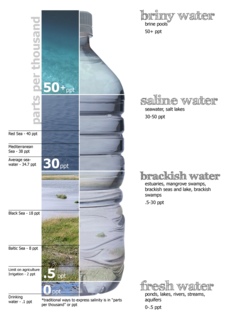List of bodies of water by salinity
Appearance
| Part of a series on |
| Water salinity |
|---|
 |
| Salinity levels |
|
Fresh water (< 0.05%) Brackish water (0.05–3%) Saline water (3–5%) Brine (> 5% up to 26%–28% max) |
| Bodies of water |
This is a list of bodies of water by salinity that is limited to natural bodies of water that have a stable salinity above 0.05%, at or below which water is considered fresh.
Water salinity often varies by location and season, particularly with hypersaline lakes in arid areas, so the salinity figures in the table below should be interpreted as an approximate indicator.
References
- ^ Perez, Eduardo; Chebude, Yonas (April 2017). "Chemical Analysis of Gaet'ale, a Hypersaline Pond in Danakil Depression (Ethiopia): New Record for the Most Saline Water Body on Earth". Aquatic Geochemistry. 23 (2): 109–117. doi:10.1007/s10498-017-9312-z.
- ^ "Guiness World Records".
- ^ Hammer, U.T. (1986). Saline Lake Ecosystems of the World. Springer. p. 109. ISBN 9789061935353. Retrieved 27 March 2018.
- ^ Aladin, Nicolai; Plotnikov, Igor (28 June 2004). Lake Basin Management Initiative - The Caspian Sea (PDF) (Report). p. 6. Retrieved 4 May 2018.
- ^ Woodward, Susan L. "Saline Lakes". Biomes of the World. Radford, Virginia: Department of Geospatial Science, Radford University. Retrieved 4 May 2018.
- ^ Goetz, P.W. (ed.) The New Encyclopædia Britannica (15th ed.). Vol. 3, p. 937. Chicago, 1986
- ^ a b White, James S.; Null, Sarah E.; Tarboton, David (2004). "More than Meets the Eye: Managing Salinity in Great Salt Lake, Utah" (PDF). LakeLine (Fall 2004). North American Lake Management Society: 25–29. Retrieved 26 April 2018.
- ^ "Lake Urmia". Encyclopædia Britannica Online. 2012. Retrieved 28 August 2012.
- ^ Little Manitou Lake. The Canadian Encyclopedia.
- ^ Willever, Katherine Lynn (2016). "Biogeochemistry of a Saline, Alkaline, Terminal Lake Ecosystem in Transition; Walker Lake, Nevada". UNLV Theses, Dissertations, Professional Papers, and Capstones (2817): 15. Retrieved 4 May 2018.
- ^ Suosaari, Erica; Reid, Pamela; Playford, Phillip; et al. (2016). "New multi-scale perspectives on the stromatolites of Shark Bay, Western Australia". Scientific ReportsPMC4738353. 6 (20557): 20557. doi:10.1038/srep20557. PMC 4738353. PMID 26838605. Retrieved 4 May 2018.
{{cite journal}}: Explicit use of et al. in:|last4=(help) - ^ "The Salton Sea". The Salton Sea Authority. October 1997.
- ^ "Ocean salinity". Science Learning Hub. Retrieved 2 July 2017.
- ^ A. Anati, David (March 1999). "The salinity of hypersaline brines: Concepts and misconceptions". International Journal of Salt Lake Research. 8: 55. doi:10.1023/A:1009059827435. Retrieved 3 February 2016.
- ^ The Biology and Culture of Tilapias: Proceedings of the International Center for Living Aquatic Resources Management, p.38
- ^ https://www.sciencelearn.org.nz/resources/686-ocean-salinity
- ^ "Beaufort Sea". Great Soviet Encyclopedia (in Russian).
{{cite web}}: Cite has empty unknown parameter:|dead-url=(help) - ^ Indian Journal of Marine Sciences - Variation of Water Quality of Chilika Lake, Orissa
- ^ Black Sea - Encyclopedia of Ukraine
- ^ Yama, Tomonaga (22 March 2017). "Porewater salinity reveals past lake-level changes in Lake Van, the Earth's largest soda lake". Scientific Reports. 7 (7). Nature. Bibcode:2017NatSR...7..313T. doi:10.1038/s41598-017-00371-w.
- ^ Lake Basin Management Initiative - The Caspian Sea (2004)
- ^ Orlovsky, Leah; Matsrafi, Offir; Orlovsky, Nikolai; Kouznetsov, Michael (2014). "Sarykamysh Lake: Collector of Drainage Water – The Past, the Present, and the Future". The Turkmen Lake Altyn Asyr and Water Resources in Turkmenistan. The Turkmen Lake Altyn Asyr and Water Resources in Turkmenistan. The Handbook of Environmental Chemistry. Vol. 28. Berlin/Heidelberg: Springer-Verlag. p. 107. doi:10.1007/698_2012_191. ISBN 978-3-642-38606-0.
- ^ Long Term Temperature & Salinity Records from the Baltic Sea Transition Zone
Notes
- ^ Some bays have considerably lower salinity.
Bibliography
- Johanna Laybourn-Parry; Jemma L. Wadham (2014). Antarctic Lakes. Oxford University Press. pp. 92–94. ISBN 978-0-19-967049-9.
